This page concerns the early years of my paternal grandmother, Adele Kurlandski, née Nawrocki. Her first grandchild, Cathy Kurlandski (later Cathy Schwartz) began calling her “Mimi” when she was just learning to talk, and the nickname stuck.
Note: a lot of the images on this page which appear small have links at the bottom-left that offer an enlarged version.
Casimire and Cecilia
Mimi’s parents were Casimire Nawrocki and Cecilia Jurkiewicz. Their first child was Julie (or Julia), born somewhere around 1904. Adele, or Adelaide, was born 3 years later, on January 29, 1907. Here's a family tree that focuses just on Adele, her parents and her children, ignoring all siblings.
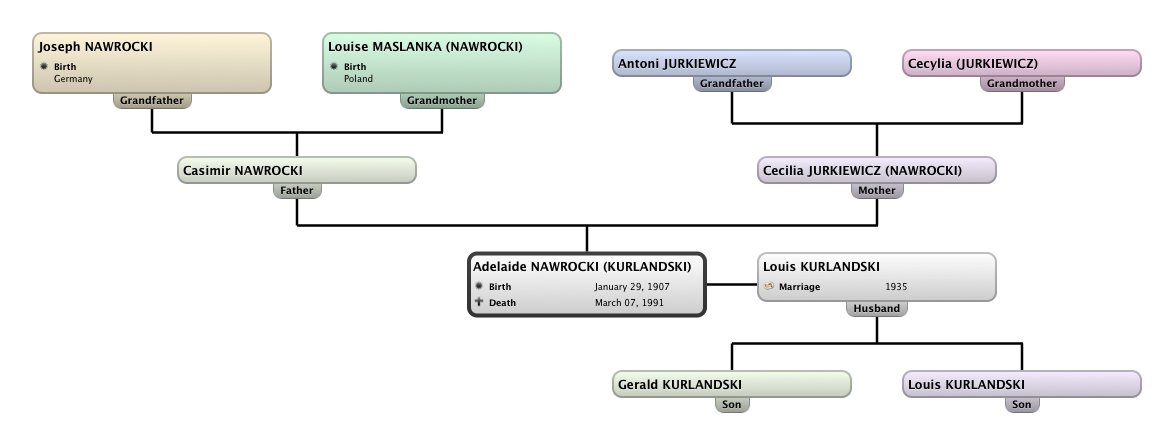
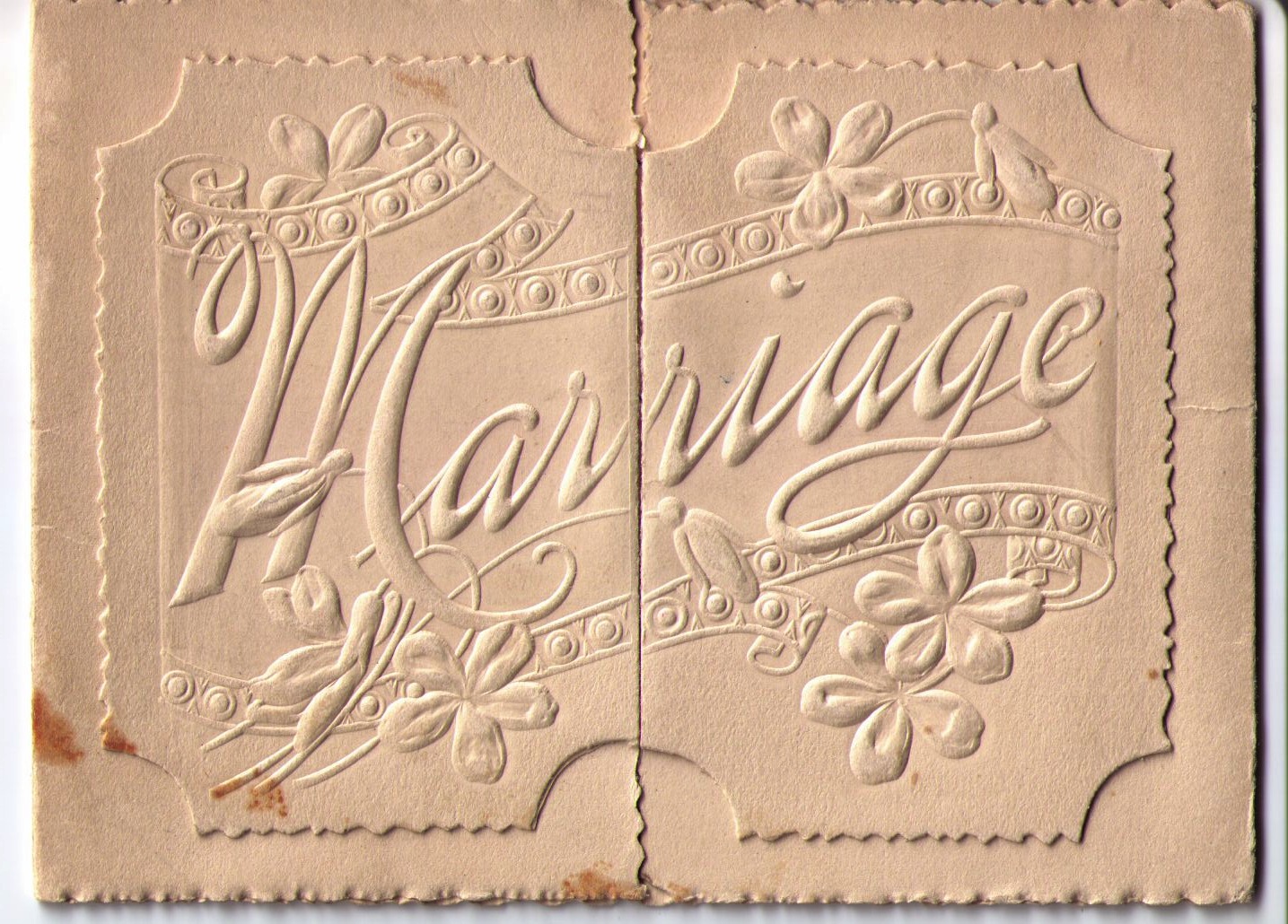
The next few pictures show Casimire and Cecilia's wedding invitation. The most interesting thing about it is that it was written entirely in Polish. For that reason I asked a work colleague to translate it for me.
Note that the wedding ceremony was held at the same St. Stanislaus Church mentioned in the pages concerning the Kurlandski side of my family.
What doesn’t make sense is the date of the wedding, specifically the year, which seems to read “1908.” Until we get our hands on a some kind of official document, I suppose we won't know for sure, but what is most likely to have happened is that the date originally read "1903" and what was once a “3” bled, over the course of the last hundred years, to make the digit appear to be an “8” now. (But see Mystery of the Misdated Invitation note below.)

For the record, here's the original, untranslated version:
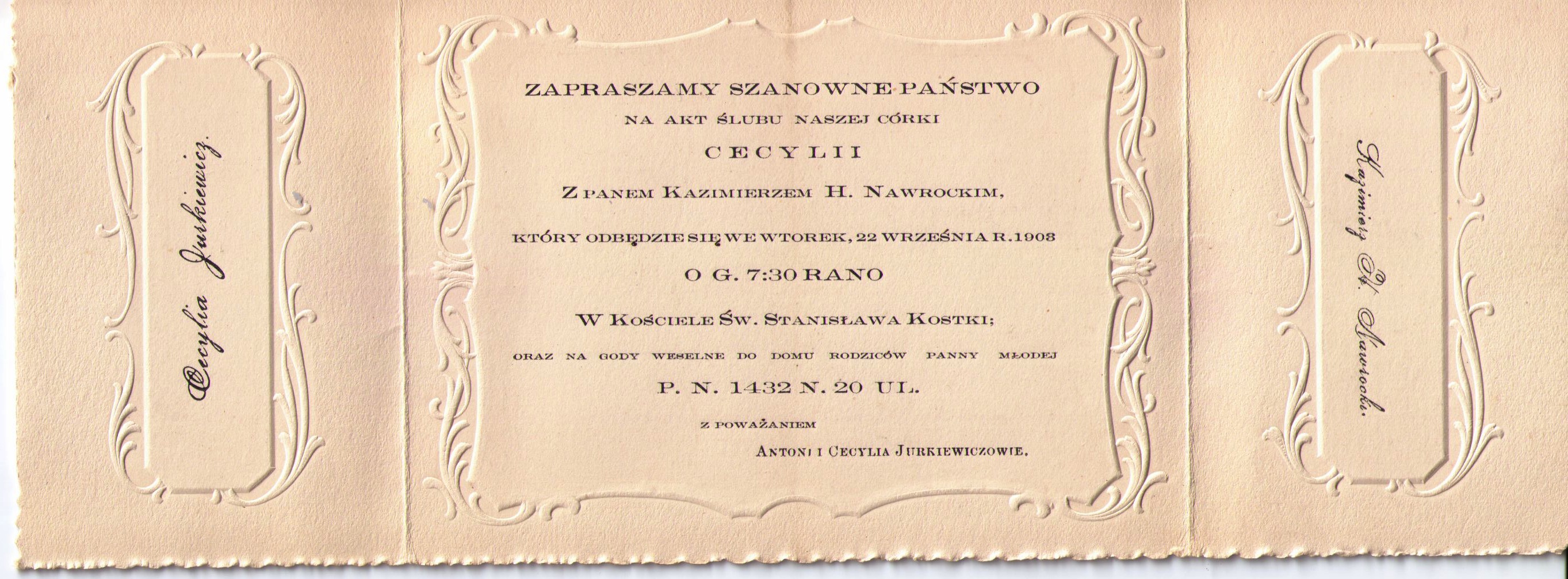
As we have said, Mimi was born in January of 1907. Sadly, Cecilia never got to spend much time with her second daughter, for she died very shortly after the birth. The story goes that after Mimi was born, the medical staff did not clear all the afterbirth out of Cecilia’s womb, hence she took sick and shortly after died of perontinitis (blood poisoning).
I've done a little googling on this, and I suspect that Cecilia's actual cause of death was puerperal fever, "a condition that results from an infection of the female reproductive organs, contracted during or following childbirth or miscarriage" (Wikipedia: "Puerperal fever").
Baby Adele was sickly, and almost went the way of her mother. She couldn’t keep down the milk they fed her and she became undernourished. Finally, it is said, somebody suggested they try goat’s milk, and she started to respond. Nevertheless, most of her young life, up to her teens, she was never a very healthy child. The family story is that it had something to do with her lungs: the X-rays showed something, but it wasn’t TB.
In the context of Cecilia’s death and her daughter’s difficult childhood, it seems worth mentioning that Cecilia had a sister, Estelle, who died at a very young age. Another interesting fact, medically speaking, is that Casimire was a pharmacist, and his father and his brother Joseph were both doctors. (But see 1910 Joseph Nawrocki Census Page, below.) This may have come in handy as the family tried to care for little Adele—there wasn’t a lot of cash to spare.
Enter Gram Nawrocki
Here we discuss a delicate matter, for it paints a much-loved member of the family in an unflattering light.
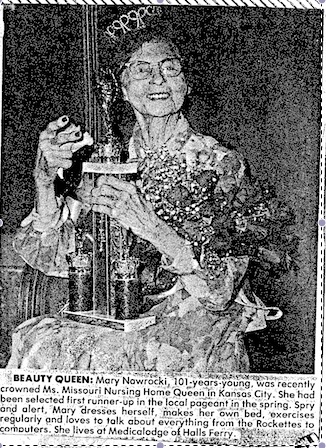
Soon after Cecilia died, Casimire married Mary Lewandowski. The new bride became Mary Nawrocki, of course, and she would live to be over a hundred years old. Eventually she became known as "Gram Nawrocki." Here is a picture taken of Mary when she was 102 and crowned "Ms. Missouri Nursing Home Queen." Family lore has it that she gave her crown to Kelly Kurlandski, my Uncle Lou Kurlandski's youngest daughter.
My single best opportunity to get to know Gram Nawrocki occurred on my high school graduation. She would have been about 95 then. My mom and dad celebrated the occasion with a party, and she was invited. For some reason she lost her ride--probably Vick and Florence Marchlewski--and I was the only available driver. I picked her up at the old folk’s home and drove her the hour to our house. In the family there seemed to be some concern that having a teenage boy as her chauffeur might have worried or flustered her, but when we arrived she made a point of saying what a good driver I was.
In the car we talked non-stop all the way. And we continued talking during the entire party. I was young, a little bit shy, and, I suppose, awkward at making conversation with the older relatives who had come to the party. So I stayed next to Gram and let people come to me. On the whole I had a good time at my graduation party.
But it’s true that I did not know her well. She only rarely put in an appearance at the Kurlandski holidays. For the most part she seemed to be member of the Marclewskis, that is, the family of Adele’s sister, Julie. And it must be said that Mimi, who rarely spoke ill of anyone, had very little to say about Gram when, one day, I began making enquiries into Mimi’s early life. She said nothing explicitly derogatory about her stepmother, but I could tell that unhappy memories were being brought to the surface, and I had a hard time getting Mimi to provide any details.
So I cannot reconcile the Gram Nawrocki I knew with the woman who became my great-grandfather Casimire's second wife. Of course I don’t know what really happened. What I describe below is merely what people say happened.
It seems fair to say that Mary Lewandowski was not a very maternal woman, for, according to oral history, she declared that she did not “want to fool around with a sick baby”—that is, baby Adele. She and Casimire never had any children of their own.
As per their "prenuptual agreement," Casimire’s parents, Joseph and Louise Nawrocki, took in Adele. Although Mary is said to have expressed a willingness to raise Julie, Louise kept both girls, insisting, “You’re not going to separate them.” Louise was known as Babka (Polish for "Grandma").
Early Years
Census data corroborates some but not all of the information above. The 1910 Census has Adele in her grandparents' home at 4709 Minnesota Avenue, but not Julie.
| Name | Relationship | Gender | Age | Birthplace | Year Immigrated |
|---|---|---|---|---|---|
| Joseph Nawrocki | Head | M | 56 | Germany | 1872 |
| Louise Nawrocki | Wife | F | 57 | Germany | 1872 |
| Anna Nawrocki | Daughter | F | 22 | Missouri | |
| Frank Nawrocki | Son | M | 17 | Missouri | |
| Louise Nawrocki Jr. | Daughter | F | 14 | Missouri | |
| Adelaide Nawrocki | Granddaughter | F | 3 | Missouri | |
| FamilySearch.org, Joseph Nawrocki/1910 |
The same census has both Adele and Julie living in their father's home with their stepmother, Mary.
| Name | Relationship | Gender | Age | Birthplace |
|---|---|---|---|---|
| Casimire Nawrocki | Head | M | 30 | Missouri |
| Mary E Nawrocki | Wife | F | 26 | Illinois |
| Julia J Nawrocki | Daughter | F | 5 | Missouri |
| Adelaide F Nawrocki | Daughter | F | 3 | Missouri |
| FamilySearch.org, Casimire Nawrocki/1910 |
Obviously, the two families did not get their story straight in advance of the 1910 Census.
There are a number of ways to reconcile the oral history with the census data. The scenario that makes the most sense to me would have it that Julie spent most of her time with her father and step-mother, and Adele lived almost entirely with her grandparents. But Casimire, filling out the census (or speaking to the census taker at the door), painted the situation as he would have wanted it to be—and not as it actually was.
Whatever the situation on the ground in 1910, the 1920 census data show Casimire and Mary living alone. Their ages are listed as 39 and 36, respectively, and there is no mention of children.
The same census has both Julie and Adele living with their grandparents.
| Name | Relationship | Gender | Age | Birthplace | Year Immigrated |
|---|---|---|---|---|---|
| Joseph Nawrocki | Head | M | 65 | Poland | 1872 |
| Louise Nawrocki | Wife | F | 67 | Poland | 1872 |
| Frank J. Nawrocki | Son | M | 27 | Missouri | |
| Louise Nawrocki | Daughter | F | 24 | Missouri | |
| Julia Nawrocki | Granddaughter | F | 15 | Missouri | |
| Adelaide Nawrocki | Granddaughter | F | 12 | Missouri | |
| FamilySearch.org, Joseph Nawrocki/1920 |
1910/1920 Census Notes
Note some other interesting differences between the 1910 and 1920 censuses for Joseph and Louise:
- Daughter Louise is no longer listed as a "Junior."
- Poland is listed as their birthplace rather than Germany (see Polish-German History note below).
- And, finally, Anna, their eldest, has moved out.
This leads us to the next section, for I knew Anna as "Ciocia".
Ciocia and Wujek Move In
In 1910 Louise and her family were living at 4709 Minnesota Avenue. Louise and Joseph owned the building and occupied the ground floor flat. At some point in time later, their daughter Anna married Frank Jankowski, and the two of them started their own family in the flat upstairs.
Those are the facts. According to my notes, the story behind these facts goes something like this: sometime between 1910 and 1920, the newly-widowed Babka found herself with no means of support apart from the building she lived in. To get by, she would have to rent out the flat upstairs, so the Jankowskis moved in. They paid Babka a (presumably modest) rent so that she was able to keep the house.
But my notes must be wrong, for, according to the census, Joseph Nawrocki was still alive in 1920. I cannot find Frank Jankowski in the 1910 census data, but the 1920 census has him and Anna living above Louise and Joseph. (Interesting tidbit, the census page linked to at 1910 Joseph Nawrocki Census Page, indicates that the family's upstairs neighbor was a certain Frank G. Jannchowski, married to Helen F. So sometime between 1910 and 1920, Frank Jannchowski moved out, and Frank Jankowski moved in.)
I knew Anna as "Ciocia," Polish for Aunt. As a child, I pronounced the word as "Chu-chu," with a short u as in "chunk." But a more correct pronunciation of the word can be found here. (At least, as long as the link remains alive.) I never knew Frank, Ciocia's husband. My dad called him "Wujek" ("maternal uncle"). Its pronunciation can be found here.
Ciocia and Wujek would eventually have four daughter—Helen, Anna-Marie, Florentine and Frances. They were Mimi's first cousins.

The four girls might have seemed like sisters to Adele, so closely did she grow up with them, especially once Babka's husband, Joseph, died.
When Anna was expecting Anne-Marie, Babka sold the building and gave Wujek the money for a down payment on a house on Pulaski Street. Then Babka, Adele and perhaps even Julie moved in with Ciocia and Wujek at 3227 Pulaski near St Hedwig’s Church. Shortly after that Julie married Vick Marchlewski, and shortly after that Adele moved in with these two newlyweds.
Presently I don't have dates for any of these events. The 1930 Census shows Wujek as the head of the household, living with his mother-in-law Louise and his niece, Adele, in addition to his wife and four daughters. So the question arises whether Adele really did move in with Julie and her new husband. Perhaps Julie married, then the census was taken, and then Mimi moved in with her sister.
| Name | Relationship | Gender | Age | Birthplace | Year Immigrated |
|---|---|---|---|---|---|
| Frank Jankowski | Head | M | 41 | Missouri | |
| Anna Jankowski | Wife | F | 42 | Missouri | |
| Frances Jankowski | Daughter | F | 13 | Missouri | |
| Helen Jankowski | Daughter | F | 11 | Missouri | |
| Florentine Jankowski | Daughter | F | 7 | Missouri | |
| Anna M. Jankowski | Daughter | F | 3 | Missouri | |
| Louise Nawrocki | Mother-in-Law | F | 77 | Poland | 1872 |
| Adelaide Nawrocki | Niece | F | 23 | Missouri | |
| FamilySearch.org, Frank Jankowski/1930 |
Wherever she was living, in 1935, Mimi married Louis U. Kurlandski, my grandfather.
Years and years later, Ciocia lived downstairs from Mimi on Louisiana Street. By this time they were both widows. Though she lived right below, almost the only time I ever saw Ciocia was when I carried dinner down to her from family gatherings at Mimi's, she being too infirm to join us upstairs. I remember her flat as always dark, with a single light shining from the recesses. "Ciocia?" I would call out. "Here," she would answer, and slowly come into the light pushing a walker in front of her. She was always grateful for the food, as well as for my delivery of it. She wanted me to know she was glad to see me. As I got older I would spend more time talking to her, but never for more than a couple of minutes.
From '68 to '72, my family was living in Cleveland, so we saw her only in our annual visits to St. Louis. I remember that every time we would pack up the car to head back home, Ciocia would start crying, believing that that would be the last time she would see us. Not an unreasonable assumption, given that she'd been born in 1888.
Ciocia died in 1974, when I was about 12 or 13. I remember the funeral parlor. I was standing in line with my younger sister, Chris. Being just a kid, I had no concept of long-range planning, no capability of medium-range planning, and was barely functional when it came to imagining what I would do for the next 30 minutes into the future. So when Chris and I found ourselves at the front of the line—the next ones up to stand before the coffin itself—I was completely unprepared. What to do? Thankfully we had the example of those who had come before us: Chris and I knelt down. Ciocia was the first dead person I had ever seen. I remember barely recognizing her in the coffin before me.... Following the example of those before us, Chris and I crossed ourselves and began going through the body language of prayer. After that first glance, I remember carefully preventing my eyes from resting on her body, and at the same time I clearly remember a hyper-sensitivity to the living, breathing adults nearby. They were making note of my sister and me, calling attention to the fact that we were two children praying beside their dearly departed loved one. As for me, I didn't know what I should be praying for, but I was more than happy to provide what little consolation I could to the adults nearby. If my praying at the side of Ciocia's coffin helped them with their grief, I was more than happy to provide the service.
Notes
Some of my information comes from FamilySearch.org. I provide more details about this website in separate notes.
Mystery of the Misdated Invitation
(referenced in Casimire and Cecilia)
(August 2021) A careful look at the invitation discredits my "8-bled-into-a-3" hypothesis completely. Enlarge the image and compare the '8' in '1908' to the two 3's on the invitation. In that font, the '8' and the '3' are very different. At the moment I am not inclined to see it as an 8 that bled into a 3. For additional notes see Mystery of the Misdated Invitation on the separate Notes page.
(September 2021) I've been going through my notes, putting everything of value onto this website—either on the main pages or in the notes pages—and I have found an email dated April 15, 2014 from my father:
The wedding was on September 22, 1903. Verification came from a photo that is in the same folder as the invitation. The photo was a family gathering "the day after the wedding" and it is dated September 23, 1903.
The 3 which looks like and 8 on your copy is a smaller type font than that used for the 3 in the lower portion of the invitation and apparently it "filled in" during the copying process.
(November 2020) This is typical of my experience in these adventures in genealogy. Not everything is always perfectly clear. Or, rather: there's a lot that you'll never know for sure.
Casimire's Second Marriage
Click here for a record of Casimire's marriage to Mary "Levindosky."
Polish-German History
(referenced in 1910/1920 Census Notes on this page, as well as in Kurlandski 1910 Notes)
While I agree that reality is always more tumultuous than "History" would have it, Polish history seems to me more tumultuous—and certainly harder to summarize—than most national histories. Try reading Wikipedia: "History of Poland", then summarizing the years 1850-1920 in a few sentences. Let's just say this: There was long a Polish people, but often they existed without a Polish state. What was once a part of Germany became a Polish nation after World War I. And Joseph and Louise's census forms, however trivial they might seem in the grand scheme of things, reflect the heady changes going on in Europe at the time. As American as they were, with both feet firmly planted in the Midwest of the United States, it's not difficult to imagine that, while in 1910 they had been forced to say that they had emigrated here from Germany, ten years later they were quite proud to declare that, actually, they had come here from Poland.
Which to me is reminiscent of the slowly evolving religious icons my grandmather, Mimi, (aka Adele—remember Adele, the main character of this web page?) kept around her flat. I remember a profusion of pictures of relatives, and drawings of saints and Jesus. But the only pope I remember is a little guy, practically a wallet photo, stuck in the bottom-right corner of the frame securing a much larger picture. Until JP II. Suddenly, from 1978 on, pictures of the Pope were sprouting out of the woodwork in her place, like forest mushrooms after a rain.
Also of interest to this topic is the 1910 Joseph Nawrocki Census Page. Note that the street is full of people born in Germany, but, for every one of those immigrants, the census taker has dutifully distinguished the German Germans from the Polish Germans.
1910 Joseph Nawrocki Census Page
In August 2021—long after I wrote this page—I downloaded Joseph Nawrocki's census page from FamilySearch.org.
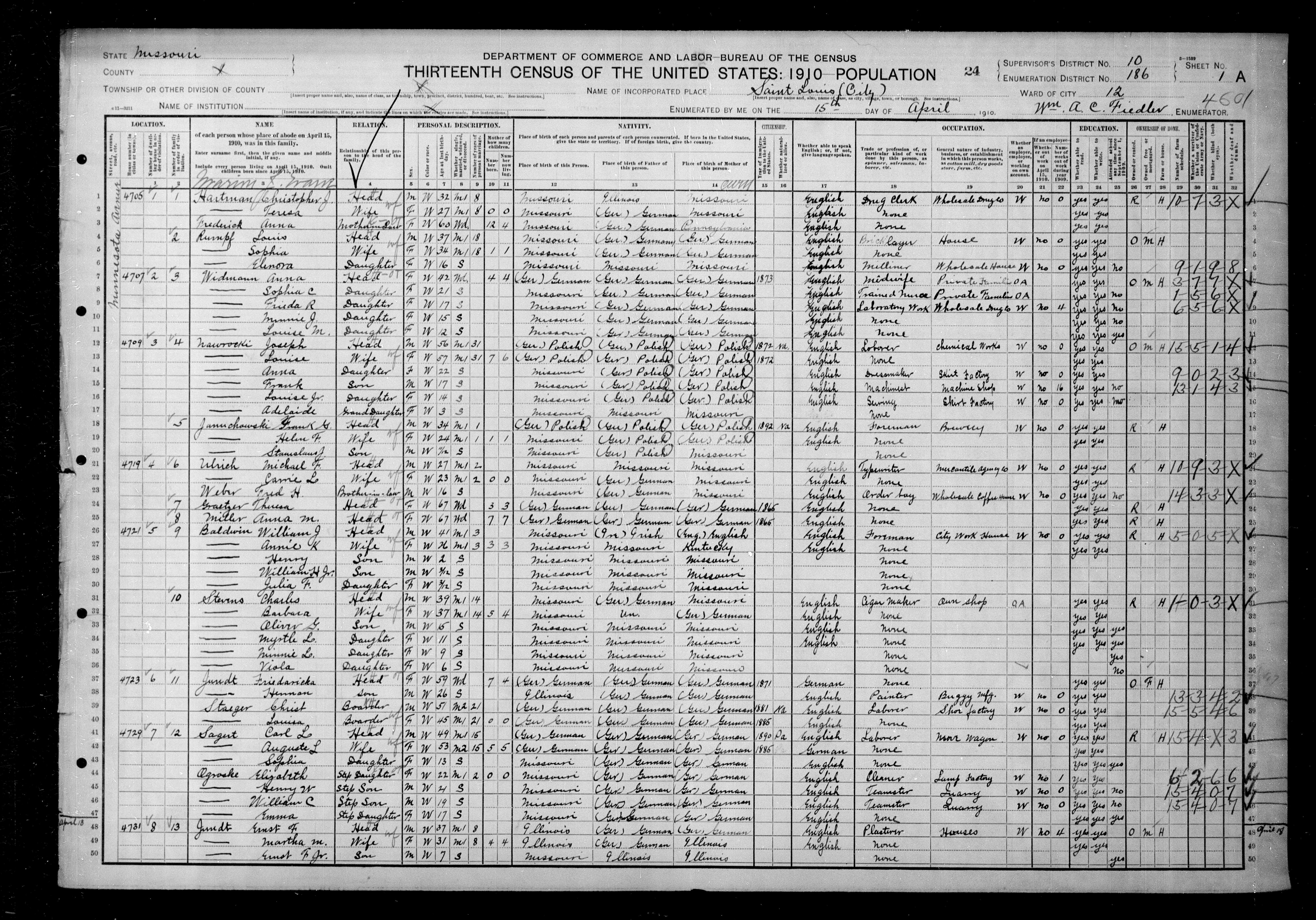
The page casts doubt on the family story that Joseph Nawrocki, Sr. was a doctor, as repeated at the end of Casimire and Cecilia, above, since in the census he reported himself to be a "Laborer" in the "Chemical Works" industry.
